
Common Articulation Disorders (Speech Issues) in Children Explained
Children learn a language when they are in their mother’s womb. They can easily pick up the language or languages they hear from their mom, other family and people in their environment. However, learning to speak a language takes time, and each child develops at their own pace. By age 5, most children can perfectly use language. Yet, many have speech issues. They may struggle with certain sounds, words, and sentences.
Some children may even show signs of normal language and speech development but still fail to produce certain sounds (called phonemes). This can result in difficulty with pronunciation and articulation. This article highlights and explores the common examples of issues that many children face in their speech.
When is it a Speech Issue?
Mispronunciations and errors in speech are common among young children as they learn to talk. Adults around them may find these mistakes cute or just waive them as baby talk. But as your child grows older, their articulation skills improve, and their speech usually becomes much clearer. Most children outgrow this ‘baby-talk’ phase naturally. If a child is having difficulty producing sounds and communicating after the age of 3-5, it may be a sign of a more serious problem.
It is normal for children to take some time to develop their speech properly, and there can be minor delays in developing some speech abilities. However, a prolonged delay may be caused by a speech issue in certain Apraxia of Speech.
If you suspect your child is affected by a speech issue, your doctor may refer you to a pediatric neurologist or a speech therapist. Common speech issues in children include articulation disorders, phonological disorders, and stuttering.
A speech issue is diagnosed when a child has difficulty producing certain sounds correctly. This can happen when a child has difficulty forming the sound correctly or cannot say the sound at all.
Speech issues are typically diagnosed when a child has difficulty producing age-appropriate sounds or when their speech is so unclear that it is difficult to understand. If your child is having difficulty producing certain sounds, they may need speech therapy to help them learn how to produce the sound correctly.
Common Articulation Disorders in Children
Certain children may experience difficulty understanding and speaking and may need extra help. If your child does not reach language milestones at the same rate as other children, it may be a sign of a language or speech delay or disorder.
Here are the most common examples of articulation disorders in children:
#1. Apraxia of Speech
Apraxia of speech is when a child has difficulty with speech production or the physical act of producing speech sounds. This means the child’s brain has difficulty planning the precise movements needed for speech, even though the child understands what they want to say and the muscles are strong enough to produce such sounds. This can make it difficult for children to talk with their peers or to express their needs to their parents. It can also make it difficult for children to learn to read and write.
Apraxia of speech can affect individuals at any age, but it is more common in children. It is also more common in children with other speech or language disabilities.
In simpler terms, the child’s brain cannot control or plan which oral muscles to use to make certain sounds. It is a problem with the motor planning or sequencing of the speech-producing muscles (lips, jaw, tongue, soft palate). The brain struggles to tell the speech muscles how and when to move to produce sounds, syllables, and words correctly and consistently.
Childhood apraxia of speech is a neurological speech sound disorder in which the precision and consistency of movements involved in speech are impaired. Apraxia of Speech affects a child’s ability to accurately, fluently, and consistently produce sounds and syllables. Children with Apraxia of Speech have difficulty saying even simple words, and their speech may sound challenging to understand or even unintelligible. They may also have difficulty coordinating the muscles used for speech, which can lead to various speech patterns, including slow, choppy, and monotone speech.
Apraxia of Speech is usually present from birth but may not be diagnosed until a child is older. It is not always easy to diagnose because children’s speech and language development can vary. Some signs of Apraxia of Speech include difficulty saying sounds, stringing words together, and following directions. Children with Apraxia of Speech may also have difficulty controlling the pitch, loudness, and speed of their speech.
To diagnose Apraxia of Speech, a speech-language pathologist (SLP) also called a speech therapist will complete an assessment of the child’s communication skills. This may include an examination of the child’s speech, language, cognitive abilities, and oral motor skills. The speech therapist may also use standardized tests and observe the child’s speech in different contexts.
Treatment for Apraxia of Speech typically involves speech therapy. Speech therapy aims to help the child learn to use their muscles correctly to produce speech. This may involve imitation, repetition, practice, and strategies to help the child learn how to use their muscles correctly. The speech therapist may also offer parent training to help the child practice their speech at home.
#2. Stuttering
Stuttering is a speech issue that affects how fluent your child’s speech is. A child who stutters may repeat words or parts of words. They may struggle to start a word or sentence. They may prolong certain sounds, or exhibit other behaviours that would disrupt their speech. These children may feel embarrassed or anxious about their speech. And that can lead to social, emotional, and even educational challenges.
It is true that everyone stumbles through their words now and then. Close to 1 million people in Nigeria stutter, and that affects education and how we view the said individuals. If we take 10 out of 100 children with stuttering issues, up to 6 of them will outgrow it. However, at this juncture, I must add that we must not confuse stuttering with another speech issue called cluttering.
Back to the point. You may notice that your child is starting to stutter between the ages of 2 and 5 and is more common in boys than girls. Experts believe that stuttering is caused by both genetic and environmental factors. While there is no specific treatment for stuttering, speech therapy and other interventions can help reduce stuttering. And can teach your child ways to improve their communication skills.
Speech therapy for stuttering would focus on helping the child control their speech. That may involve them learning to reduce the physical tension when trying to produce difficult sounds. So, the therapist may teach the child techniques like slowing down the rate of speech, pausing, and stress on syllables to make speech easier and more fluent.
#3. Dysarthria
Dysarthria is a motor speech issue that results from weakness or poor control of the muscles used for speech. That means, as opposed to Apraxia of speech, the brain can control the muscles but the muscles are too weak to work. Dysarthria can make a child’s speech sound slurred, slow, or difficult to understand. Dysarthria is a motor problem. The child can hear you, they can think, write and use language correctly, but their oral muscles are too weak to say the sounds correctly.
Treatment for dysarthria typically involves speech-language therapy. A speech therapist will evaluate the child’s speech and language skills and design an individualized treatment plan. The therapy would aim to strengthen the child’s muscles with exercise and muscle building techniques which may include diet plan, sleep routines, and so on.
In many case, the speech therapist may recommend augmentative and alternative communication (AAC) devices. These are devices the child can use to communicate while learning to use their voice.
#4. Lisping
Lisping is a very common type of speech sound error that involves the incorrect production of the sibilant sounds, mainly /s/ and /z/. The error occurs due to an improper placement of the tongue. The most common form is the interdental (frontal) lisp, where the tongue stays between the front teeth, causing the /s/ sound to sound like “th” (e.g., “sock” becomes “thock”). A frontal lisp is a normal part of speech development up to about 4.5 years old and often resolves on its own. However, a lateral lisp, where air flows over the sides of the tongue creating a distinct “slushy” sound, is not developmentally typical at any age and usually requires attention. if your child still speaks with a lisp after the age of 4.5 to 5 years old, it is no longer a part of typical speech development and can become a deeply ingrained habit.
For persistent or non-typical lisps, a speech therapist will use targeted therapy techniques to retrain the child to correctly position their tongue behind the teeth for clear sound production.
To treat your child’s lisp, please work with a speech therapist to correct the sounds that are difficult to pronounce. This may include coaching on proper pronunciation, relearning how to form specific sounds or words, and practicing in front of a mirror to see the correct tongue placement. A speech therapist may also recommend exercises to strengthen the speech muscles, such as drinking through a straw.
Experts recommend seeking professional intervention from a speech-language pathologist as early as possible. For an interdental or dentalized lisp, it’s advised to consult an SLP if the lisp persists in a child who has reached the age of four.
#5. Sound Omission
Sound omission is a speech disorder where a child omits certain sounds or syllables when speaking. The child can even leave out part of a word or omit entire words when speaking. Instead of forcing their developing mouth muscles to coordinate a difficult sound sequence, the child’s brain takes a shortcut for the sake of clearer communication. For instance, a child aiming to say “shoe” might simplify it to “oo,” or they might omit the initial consonant in “hat” and say “at.”
A child’s brain knows exactly what a “shoe” is, but their small mouth and immature muscle memory aren’t yet ready to execute the precise, rapid movements required to form all the sounds in the correct sequence. Omissions are a clever, temporary fix that allows the child to prioritize getting the core message across. While nearly all children exhibit sound omissions between the ages of one and three, most children naturally “grow out” of this pattern as their speech system matures. When the pattern persists significantly longer than age three or four, it suggests the child may need external support to bridge this motor skill gap.
When a child’s sound omissions do not resolve naturally, a speech therapist provides targeted attention. The goal of this therapy is not just to “fix” the omitted sound, but to strengthen the underlying motor planning and control and build the child’s awareness of the missing sound. The speech therapist will often use techniques such as Articulation Therapy. That involves guiding the child through exercises that teach them to form the sound in isolation first. They then practice inserting that sound back into words, syllables, and eventually spontaneous sentences.
The Power of Early Intervention in Childhood Development
Early Intervention is a vital approach focused on giving specialized support the moment you notice a potential developmental challenge in a young child. It is a vital opportunity to ensure every child has the strongest possible start in life. Especially when you have observed a developmental delay or disability. Early Intervention programs will give you a set of tailored specialized services, including therapy, educational resources, and comprehensive family support. All of these are designed to help a child successfully reach crucial developmental milestones. By stepping in early, we can often promote robust overall development and prevent minor delays or speech issues from evolving into more significant obstacles later in life.
Caston Vienna Tutors offer early intervention strategies for parents. This program include Speech therapy in Port Harcourt, Homeschooling for the special needs, and parent coaching for home practice.
Identifying and Supporting Speech Issues
Children struggling with speech issues need individual attention. Speech therapists are the key professionals in this process. We work directly with the child, guide parents, caregivers, and teachers to create a supportive environment.
Crucially, formal early intervention services typically target children up to 5 years old. How will you know? When you take your child for pediatric check-ups or certain childcare programs, they may determine whether a child requires supports. Any concerns regarding a child’s hearing, behavior, or emotional health must be looked at. Everyone involved in the child’s life must work together to support that child immediately the issue is identified.
Benefits of Early Intervention
The impact of early intervention is deep. It can speed up your child’s development. You will identify potential delays and get the necessary resources for your child to rapidly catch up to their peers. With early intervention, you can reduce the risk of long-term developmental difficulties. This will provide a stronger foundation for future academic and social success. Early intervention also plays a vital role in nurturing a child’s social and emotional growth, enabling them to confidently build relationships and engage fully in the world around them.
Partner with a Speech Therapist
When your child has speech issues, the best bet is to work with a speech therapist. They are highly trained professionals that evaluate, diagnose, and treat a wide spectrum of communication and swallowing disorders. They use many tools to direct therapeutic intervention. The speech therapist crafts a customized treatment plan for your child. This plan includes targeted activities and exercises designed to improve pronunciation and articulation, such as re-teaching the correct way to make a sound, practicing in front of a mirror, or using strengthening exercises.
Another core part of their work is coaching parents and caregivers. That will help these ones to become effective helpers for the child.
Commitment to Articulation Success
Common speech issues are curable. With the right therapy support, children with these issues can thrive and reach their full potential. At Caston Vienna Tutors, we deeply understand the critical importance of strong language skills for a child’s future success, and we are dedicated to helping every child acquire the robust communication skills they need to build a brighter future.

